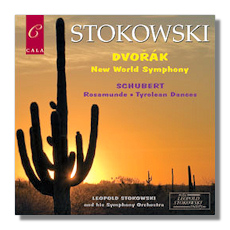
The Internet's Premier Classical Music Source
Related Links
-
Dvořák Reviews
Schubert Reviews - Latest Reviews
- More Reviews
-
By Composer
-
Collections
DVD & Blu-ray
Books
Concert Reviews
Articles/Interviews
Software
Audio
Search Amazon
Recommended Links
Site News
 CD Review
CD Review
Stokowski Conducts Dvořák

- Antonín Dvořák:
- Symphony #9 "From The New World"
- Franz Schubert:
- Rosamunde: Incidental Music
- Overture
- Entr'acte #3
- Ballet #2
- Tyrolean Dances
- Deutsche Tanze
Stokowski Symphony Orchestra/Leopold Stokowski
Cala CACD0550 76:07
I started collecting classical recordings in 1976. I began on January 1st of that year. On January 1st of the following year I decided to count my LPs. I had exactly 365. When I went searching for my first Dvořák "New World" I had no idea which recording to choose. Peaches Records had a bin with over a dozen recordings. I thumbed through and finally settled on a two-fer that had the music by the same conductor from 1927 and 1973. I decided that I had one in stereo and if I ever wanted to hear the older one (and who was this guy Stokowski that had recorded for so many years?)
Stokowski first conducted the symphony in Cincinnati on March and April 1911 with the town's orchestra. He eventually recorded it six times between 1925 and 1973. As part of this review I decided to revisit five of them. I've all but the first one in the Stokowski Collection. The particular recording here was previously released on a Japanese RCA CD but that one was difficult to locate and this one sounds significantly better anyway. The previous incarnation, like the Japanese RCA release of the Tchaikovsky 5th, sounds too bright by comparison. This CALA release captures the Stokowski sonority fully and offers excellent inner detail.
Okay, what differences or insights do the different recordings offer? Keeping in mind that the time limitations of the 78-rpm discs could have an effect on matters, the two Philadelphia recordings are faster than those that follow. For the 1927 recording I listened to the Livingera Classics incarnation rather than the Biddulph recording. The Living era, mastered by David Lennick, has more inner detail while preserving the rich bass. There is something special about listening to recordings Stokowski made in Philadelphia. By 1927 they had been working together for over a decade and the Stokowski Sound was there: the deep, rich bass, the feathery strings. While The Mysterioso (as Bernstein called him) was always able to get an orchestra to sound like HIS, the Philadelphia Orchestra recordings are special. By 1934 recording techniques, mainly in microphones, had improved so that there was better inner detail, allowing you to enjoy more of the music. The Andante recording is excellent. At this time Stokowski uses more portamento but that's fine with me. It almost sounds as if he's thinking about doing it for Disney. This interpretation is perhaps the darkest…the closing poses questions with uneasy answers. The timpani is barely audible but contributes to the miasma.
The 1940 All-American Youth Orchestra recording is dry in comparison with Stokowski's other recordings but that is the norm for the Columbia recordings. On the other hand, this recording is certainly by a youth orchestra conducted by a 60 year young conductor. It is the most intense of the recordings. I had the pleasure to know Warren Eason, who was a 16 year old playing in the orchestra and he told me about how Stokowski led recordings in a business-like no-nonsense manner but maintained a supportive role when correcting his younger players. The English horn is a bit nasal here. While the whole thing is more "youthful" than Stokowski's other recordings, the deep, rich bass sound is not here. It is intense…there are lovely solos…it is exciting. I just wish there was more of the solid bass line that distinguishes the Stokowski Sound. This CALA release, some years and technology later, is yet another improvement. His Symphony Orchestra was an ad hoc band of some of the finest musicians in the New York area at the time. Mitch Miller plays the English horn in the slow movement and this is the finest of the five recordings in the Stokowski Collection. Using the latest recording medium, tape, Stokowski was able to produce a sound that made the smallish orchestra sound like the entire New York Philharmonic. Ed Johnson tells me that another of Stokowski's innovations to create the great sound was "more me-crophones". Stokowski would tell the engineers that he could create better sound if he had more…he got them. Of all the recordings I've listened to, this one is second only to the stereo version and that is simply because stereo adds so much more nuance and transparency to the sound. Still, the tam-tam at the close of the symphony is best heard in this CALA release.
Attached to this release are the Schubert items as a lagniappe and while they are good, they are not the main reason people will want this disc.
Kudos to all involved in this project. It is nice to have this performance in good sound. If you can find them I'd also recommend one of the Philadelphia recordings, preferably the 1934.
Copyright © 2009, Robert Stumpf II




















